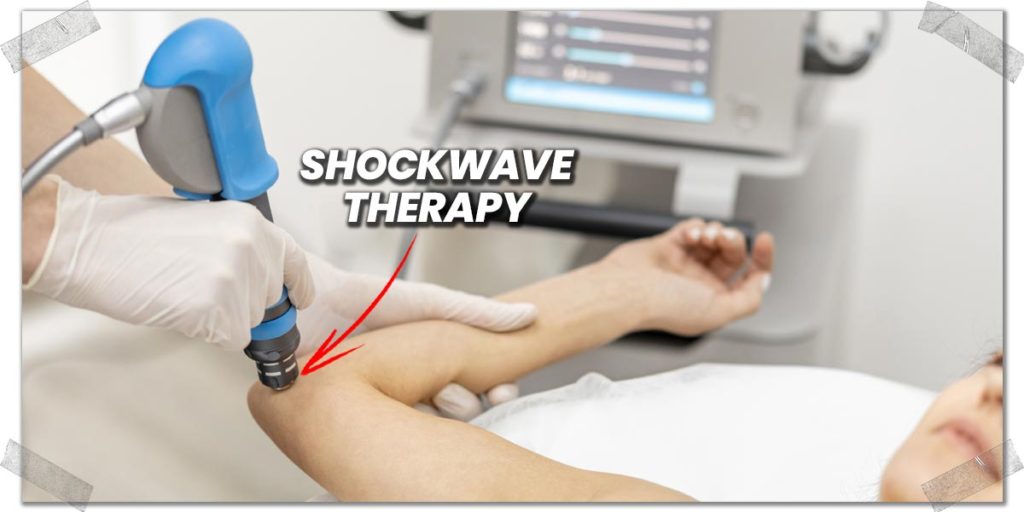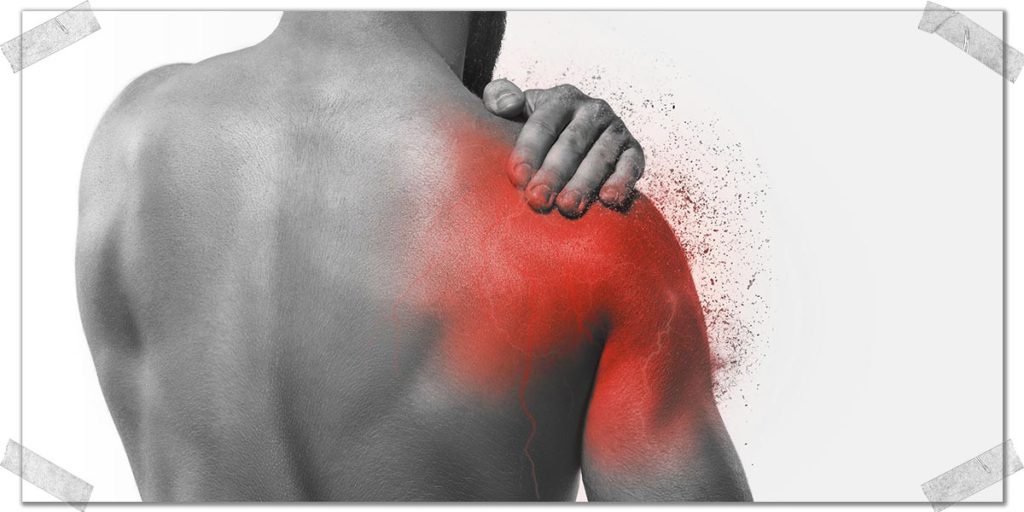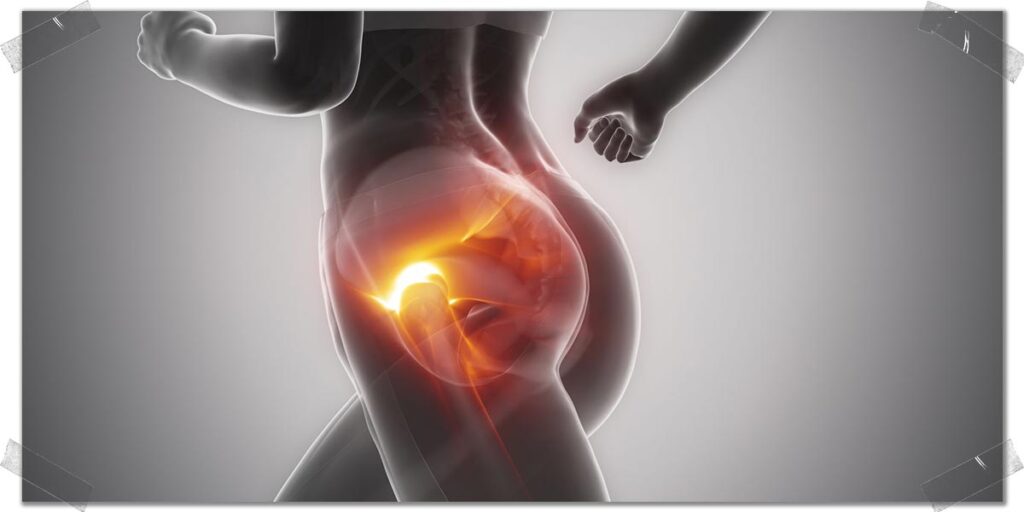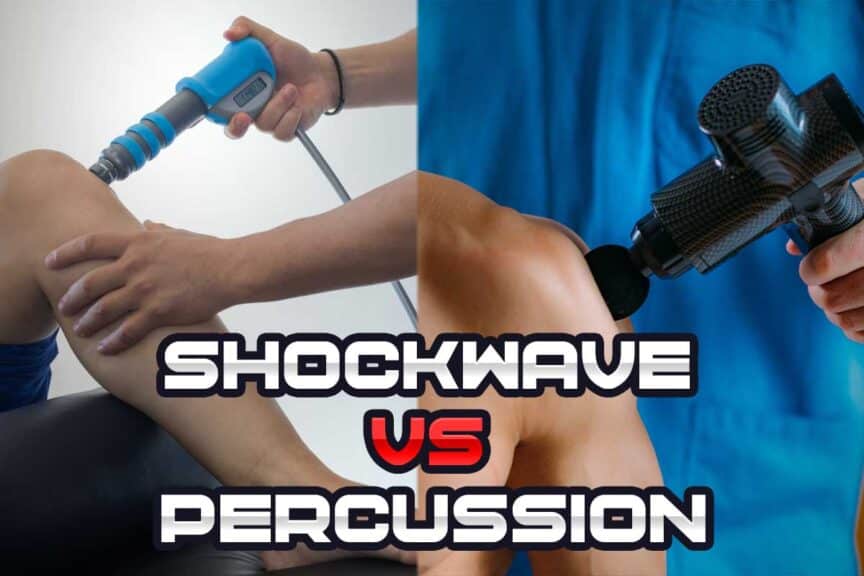They may seem similar, but massage guns and shockwave therapy are, in fact, two very different beasts. However, many individuals often conflate the two due to their seemingly outwardly similar nature. In actuality, each one has a unique mechanism of action and produces unique therapeutic effects, depending on the condition being treated.
Massage guns work primarily through percussion-induced effects (percussion therapy), while shockwave therapy works through creating high-pressure acoustic (sound) waves. Both can be therapeutic for certain conditions, but shockwave therapy is much more versatile in conditions it can treat.
As a result of their specific mechanism of action, these devices have unique conditions that they can treat and unique situations for which they should (or shouldn’t) be used.
Of course, that is the incredibly consolidated answer. There are many more specifics that can be delivered when comparing and contrasting the two interventions. So if you want all the details, keep on reading!

ARTICLE OVERVIEW (QUICK LINKS)
Click/tap on any of the headlines to jump to that section of the article
• A technical note: percussion vs vibration
• Basics of percussion therapy
• Basics of shockwave therapy
• Which one is best for YOU
Disclaimer: While I am a physical therapist, I am not YOUR physical therapist. As a result, I cannot tell you whether or not any treatments or training methodologies mentioned on this website or in this article may or may not be appropriate for you, including percussive therapy or extracorporeal shockwave therapy. By following any information within this post, you are doing so at your own risk. You are advised to seek appropriate medical advice for any pain you may be experiencing.
A technical note: percussion vs vibration
As we dive into the contents of this article, it’s worth pointing out that percussion therapy (which is how massage guns deliver their therapeutic effects) is technically not the same as vibration therapy.
Vibration, by definition, refers to an oscillation of a fluid, elastic, or solid that disrupts its equilibrium. Percussion, on the other hand, is defined as the striking of one solid object against another with a specific amount of force.
In the case of massage guns (which are percussive in nature), these devices do produce a sort-of vibrational effect, but it is the result of the physical percussion of the device head physically impacting the targeted tissue or body area.
This is worth noting since many people conflate these two different therapeutic modes as one and the same. Still, they’re technically different (and just so we’re clear, percussion therapy is in no way the same as shockwave therapy).
Nonetheless, since there is perhaps a vibrational component that occurs through percussive therapy, here’s a rapid rundown on how vibrational therapy is believed to elicit its effects:
How vibration therapy works
Vibrational stimulation is believed to produce its effects through different mechanisms of mechanical stimulation. One of the primary mechanisms is via the tonic vibrational reflex (TVR), which is a neurophysiological mechanism that is stimulated when vibrations act to rapidly stretch (and therefore trigger muscle spindles), improving the overall strength of the muscle.1,2
Related article: Vibrating Foam Roller vs Regular Foam Roller | Proven Benefits of Each
Vibration therapy also increases muscle temperature through improved blood flow. However, it is important to note that local vibrational stimulation to an area of the body is transient, meaning that the effects aren’t lasting in nature.
If you want the geeky details, you can check out these journal articles (click/tap to read them):
- Effects of local vibration therapy on various performance parameters: a narrative literature review
- Clinical applications of vibration therapy in orthopaedic practice
With that being said, let’s dive a bit deeper into the basics of percussion therapy.
Basics of percussion therapy

It stands to reason that some of the percussive effects that massage guns produce might be similar to those of vibration therapy. However, there is some scientific evidence to suggest that shockwave impulses act differently on spastic muscles than when compared to vibration therapy.3 It is also worth noting that with the frequency of massage guns being much lower than traditional vibration therapy and their delivery mode being through the physical impact of the tissue (as opposed to oscillating the tissue), their tissue-inducing effects can therefore be different. But, when it comes to comparing their therapeutic effects, there does seem to be some overlap.
While percussion therapy hasn’t been studied as extensively as shockwave therapy or vibration therapy (in terms of treating skeletal muscle and associated tissue), there is still research that supports the ability of percussive therapy to produce favorable changes to soft tissues of the body.4 These benefits include:
- Pain reduction
- Increased blood flow
- Reduced lactate
- Reduced muscle spasm
- Improved lymphatic flow
- Decreased peripheral neural drive
- Improved range of motion
Related article: Massage Gun vs Vibrating Foam Roller – Is One Better Than the Other?
Any (or some combination) of these positive effects can enhance musculoskeletal recovery and decrease delayed onset muscle soreness (DOMS) when percussion therapy is properly administered. Many of these benefits are not dissimilar to what has been found to be delivered through vibration-based therapy. Perhaps this is one of the reasons why individuals often assume vibrational therapy and percussive therapy to be one and the same.
Basics of shockwave therapy

Extracorporeal Shockwave Therapy (ESWT) has surprisingly been around since the early ’80s; however, it was initially used to treat kidney stones (through a process known as lithotripsy). It was thereafter discovered that it could be a beneficial form of treatment to other tissues in the body once healthcare providers began using ESWT to break down calcific deposits found in chronically unhealthy tendons.5 From there, interest grew even further as to other conditions for which ESWT could be used.
What are shockwaves?
In terms of what shockwaves in ESWT are, they are the result of acoustic pressure disturbances, which are the result of energy transmission from a specialized application device.6 If that sounds complicated, here’s a more straightforward way to explain them:
Shockwaves are rapid changes of air pressure that can move through tissues in your body.
There are three ways that shockwaves can be created:
- Though an electrohydraulic device
- Through an electromagnetic device
- Through a piezoelectric device.
Regardless of the type of therapeutic device used, these pressure waves are delivered to a patient through a coupling gel, as shockwaves need to have some sort of coupling medium to effectively travel between the shock plate (where the shockwave is emitted from) and the tissues they’re targeting (shockwaves don’t travel too well through the air).
When these pressure waves travel into the targeted tissue(s), these pressure waves can either be absorbed or reflected, depending on the unique properties of the targeted tissue(s). Harder tissues, such as bone, will reflect more of these waves, whereas softer tissues, such as muscles and tendons, will absorb more of them. As a result, the energy contained within the shockwaves can induce direct mechanical forces to the tissue(s) or indirect forces through a process known as cavitation.
Shockwave therapy for tendon-based pathologies.

While ESWT has been utilized for various conditions, it has been most commonly utilized for various types of tendinopathies. While plenty of studies have found ESWT to be a beneficial form of treatment, it’s important to know that the underlying mechanism(s) towards how ESWT elicits its healing effects is still relatively unknown. And for what it’s worth, tendinopathy itself is still a somewhat poorly understood pathology itself.
Theories towards the healing-based effects of shockwave therapy involve the stimulation of angiogenesis through increased cytokine diffusion within the tissue. Other theories include potential nerve fiber degeneration or stimulation of pain-relieving substances within the body.
In other words: ESWT is thought to work by improving blood supply to the targeted or unhealthy area and perhaps turning down pain signalling to the brain.
There are various forms of tendinopathy that shockwave therapy has been utilized for with success.6,7 Such tendinopathies include:
- Achilles tendinopathy
- Lateral epicondylitis of the elbow (tennis elbow)
- Patellar tendonitis
- Rotator cuff tendinopathy
These types of tendon-based issues are relatively common and thus have been studied rather extensively.
Shockwave therapy for other conditions

While it is primarily used for orthopedic conditions involving various types of tendinopathies (such as Achilles tendinopathy), it has also been successfully used for other orthopedic conditions, such as:
- Plantar fasciitis
- Calcific tendinosis
- Non-union of long bone fracture
The treatment mechanisms and other details of shockwave therapy for such conditions are beyond the scope of this article. Still, if you’d like some of the geeky, scientific details, you can check out the following scientific articles (click/tap to read them):
- Efficacy and safety of extracorporeal shock wave therapy for orthopedic conditions: a systematic review on studies listed in the PEDro database
- Extracorporeal shockwave therapy in musculoskeletal disorders
In addition to these conditions often being rather stubborn to treat, they can often be rather painful as well. As a result, shockwave therapy shines brightly here. In contrast, percussive therapy will likely not have a therapeutic impact (no pun intended) on helping to resolve these more recalcitrant issues.
Shockwave vs percussion: which one is best for YOU
I’ve made a chart between different scenarios for using each treatment method to help make this section a bit more clear and concise for you, so keep scrolling if you’d like a visual breakdown.
The quick takeaway: shockwave therapy is the more ideal treatment modality to use for injury recovery, including injuries to muscles, tendons and specific joint pathologies, but it will require you to head into a clinic for treatment. Massage guns, on the other hand, while much more practical in terms of accessibility and self-use, are best geared towards injury prevention and recovery of muscles and tendons.
The practicality of each device
While shockwave therapy can produce astounding differences in injury recovery rates for various types of injuries and conditions, you can’t exactly purchase a shockwave unit for home use (at least, not without spending multiple thousands of dollars for a truly clinically worthy unit). As a result, you’ll likely only be able to reap its effects in a clinical setting, such as a physiotherapy clinic.
Nonetheless, if you have the benefits, financial budget or access to shockwave therapy, ESWT is your best bet between the two when it comes to taking care of injured or unhealthy muscles, tendons, fascia and joints of the body.
If shockwave therapy is out of the picture for you, or if you’re just wanting to ensure that you keep your muscles, fascia and tendons in a healthy state and perhaps reduce post-exercise soreness (helping you to recover quicker), a massage gun could be the ticket for you.
Final thoughts
Shockwave therapy and massage gun therapy are two very different therapeutic modalities. Despite many individuals erroneously believing they are one and the same, they are vastly different in their mechanism of action along with the therapeutic effects they provide. If one of them is an apple, the other is an orange.
If you need to get some healing underway to unhealthy muscles, tendons or joints, shockwave therapy is likely your best bet. If you’re more interested in just giving your otherwise healthy muscles and tendons some TLC and keeping them happy, a massage gun is likely a better (and more practical) bet for your needs.
References:

Hi! I’m Jim Wittstrom, PT, DPT, CSCS, Pn1.
I am a physical therapist who is passionate about all things pertaining to strength & conditioning, human movement, injury prevention and rehabilitation. I created StrengthResurgence.com in order to help others become stronger and healthier. I also love helping aspiring students and therapists fulfill their dreams of becoming successful in school and within their clinical PT practice. Thanks for checking out my site!

